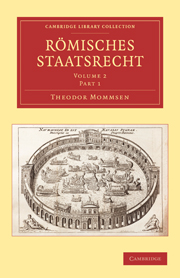Book contents
- Frontmatter
- Contents
- Das Königthum S. 3—15
- Die magistratische Befugniss des Oberpontifex S. 16—69
- Das Consulat S. 70—124
- Die Dictatur S. 125—153
- Das Reiterführeramt S. 156—164
- Der Consulartribunat S. 165—175
- Die Prätur S. 176—216
- Die Provinzialstatthalterschaft S. 217—246
- Der Volkstribunat S. 247—303
- Die Censur S. 304—442
- Die Aedilität S. 443—491
- Die Quästur S. 492—538
- Magistratische Offiziere S. 539—545
- Die magistratische Geschwornenleitung S. 546—555
- Der Vigintisex-, später Vigintivirat S. 556—571
- Ausserordentliche Beamte für die Reservatrechte der Gemeinde S. 572—600
- Ausserordentliche Aushülfsbeamte S. 601—637
- Die Senatsboten (legati) S. 638—661
- Die ausserordentlichen constituirenden Gewalten S. 662—697
Der Vigintisex-, später Vigintivirat S. 556—571
Published online by Cambridge University Press: 29 August 2010
- Frontmatter
- Contents
- Das Königthum S. 3—15
- Die magistratische Befugniss des Oberpontifex S. 16—69
- Das Consulat S. 70—124
- Die Dictatur S. 125—153
- Das Reiterführeramt S. 156—164
- Der Consulartribunat S. 165—175
- Die Prätur S. 176—216
- Die Provinzialstatthalterschaft S. 217—246
- Der Volkstribunat S. 247—303
- Die Censur S. 304—442
- Die Aedilität S. 443—491
- Die Quästur S. 492—538
- Magistratische Offiziere S. 539—545
- Die magistratische Geschwornenleitung S. 546—555
- Der Vigintisex-, später Vigintivirat S. 556—571
- Ausserordentliche Beamte für die Reservatrechte der Gemeinde S. 572—600
- Ausserordentliche Aushülfsbeamte S. 601—637
- Die Senatsboten (legati) S. 638—661
- Die ausserordentlichen constituirenden Gewalten S. 662—697
Summary
Die sechs nun zu erörternden Aemtercollegien):
IIIviri (eine Zeitlang IIIIviri) capitales
IIIviri (eine Zeitlang IIIviri) aere argento auro flando feriundo.
IIIviri vüs in urbe purgandis.
IIviri vüs extra urbem purgandis — aufgehoben im J. 734.
Xviri stlitibus iudicandis.
IIII praefecti Capuam Cumas — aufgehoben unter Augustus.
obwohl sowohl der Entstehung wie der Competenz nach durchaus selbständig — Cicero) zählt die, welche er davon überhaupt nennt, mit der Quästur zusammen als städtische magistratus minores auf — sind in Bezug auf die Aemterlaufbahn insofern als eine Kategorie betrachtet worden, als es wahrscheinlich im Laufe des siebenten Tahrhunderts ¨blich und durch Augustus vermuthlich gesetzlich vorgeschrieben ward eines derselben vor der Uebernahme der Quästur zu bekleiden (1, 450). Sie gehen sich also nicht näher an als Volkstribunat und Aedilität, nachdem Augustus diese gleichfalls zu einer Aemterstaffel zusammengefasst hatte; nur führen sie hienach neben dem speciellen noch in der früheren augustischen Zeit den allgemeinen Namen der viginti sex), später den der viginti viri). — Die Rangfolge dieser Aemter, wenn es eine gab, kennen wir nicht; die oben gegebene Folge ist wesenllich diejenige, in der Cicero und Dio sie aufzählen.
Dass diese niedrigsten Aemter, abgesehen von ihrer Specialcompetenz, auch nach Ermessen des Senats zu ausserordentlicher Aushtüfe verwendet worden sind, deutet Cicero an (S. 566 A. 2)); Belege dafür im Einzelnen besitzen wir nicht.
- Type
- Chapter
- Information
- Römisches Staatsrecht , pp. 556 - 571Publisher: Cambridge University PressPrint publication year: 2010



